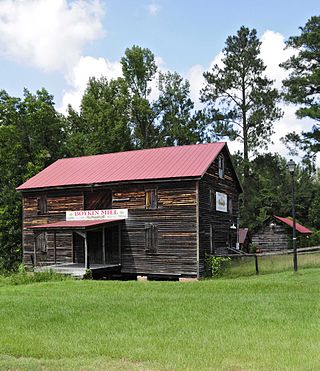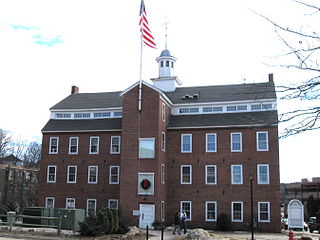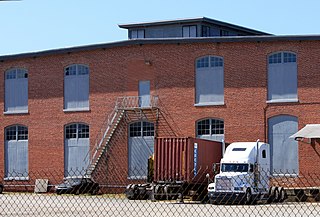
Kershaw County is a county located in the U.S. state of South Carolina. As of the 2020 census, its population was 65,403. The county seat and largest community is Camden. The county was created in 1791 from parts of Claremont, Lancaster, Fairfield, and Richland counties. It is named for Col. Joseph Kershaw (1727–1791), an early settler and American Revolutionary War patriot.

Seneca is a city in Oconee County, South Carolina, United States. The population was 8,102 at the 2010 census. It is the principal city of the Seneca Micropolitan Statistical Area, an (MSA) that includes all of Oconee County, and that is included within the greater Greenville-Spartanburg-Anderson, South Carolina Combined Statistical Area. Seneca was named for the nearby Cherokee town of Isunigu, which English colonists knew as "Seneca Town".

Bethesda Presbyterian Church is a historic church at 502 DeKalb Street in Camden, South Carolina. A National Historic Landmark, the main church building was built in 1822 and is one of few surviving churches designed by 19th-century American architect Robert Mills.

Mulberry Plantation, also known as the James and Mary Boykin Chesnut House is a historic plantation at 559 Sumter Highway south of Camden, South Carolina. Declared a National Historic Landmark in 2000, it is significant as the home of American Civil War chronicler Mary Boykin Chesnut, who produced some of the most important written accounts of the war from a Confederate perspective. The main house, built about 1820, is a fine example of Federal period architecture.

The New Mill and Depot Building of the former Hawthorne Woolen Mill are located in Greenwich, Connecticut, United States. The two structures were built on an existing textile mill complex in the 1870s.

Charles C. Wilson was an American architect in practice in Columbia, South Carolina, from 1896 until his death in 1933.

The Highland Park Manufacturing Company Mill No. 3 is a historic textile mill complex and national historic district located at 2901 N. Davidson St. in Charlotte, Mecklenburg County, North Carolina. The district encompasses included five contributing buildings and are the original mill building (1903-1904) and major weaving room addition, Gate House, Dye House, Boiler House, and Waste House (1903-1904). The original mill was designed by Stuart W. Cramer and features a four-story tower capped by fancy corbelling and crenelated parapets.
Darlington Industrial Historic District is a national historic district located at Darlington, Darlington County, South Carolina. The district encompasses 12 contributing buildings and 1 contributing structure in an industrial section of Darlington. They were built between about 1890 and 1925. All of these buildings are located along the rights-of-way of the South Carolina Western Railway and the Charleston, Sumter and Northern Railroad since the industries each of these buildings served employed the services of the railroad. Among the prominent resources in the district are the Charleston, Sumter and Northern Railway Freight Station (1891), the Darlington Roller Mill (1899), Thomas and Howard Tobacco Warehouse ; and Price's Tobacco Warehouse, and a cotton warehouse.

Boykin Mill Complex, also known as Mill Tract Plantation, is a national historic district located near Camden, Kershaw County, South Carolina. The district encompasses nine contributing buildings, two contributing sites, and four contributing structures. “Boykin Mill” denotes a community which consists of an old post office, an old general store, a c. 1905 grist mill, mill pond, mill dam, gates, and canals. The community also includes an early 19th-century Greek Revival style Baptist church, one mid-19th-century residence, three 20th-century residences built for mill workers, and a smoke house. An American Civil War battle site is also a part of the Boykin Mill community. The Battle of Boykin's Mill took place on April 17, 1865.

City of Camden Historic District is a national historic district located at Camden, Kershaw County, South Carolina. The district encompasses 48 contributing buildings, 8 contributing sites, 2 contributing structures, and 3 contributing objects in Camden. The district is mostly residential but also include public buildings, a church, and a cemetery. Camden's architecture is classically inspired and includes examples of Federal, Greek Revival, and Classical Revival, in addition to cottage-type, Georgian, Charleston-type with modifications, and mansion-type houses. Several of the city's buildings were designed by architect Robert Mills. Notable buildings include the Kershaw County Courthouse (1826), U.S. Post Office, Camden Opera House and Clock Tower, Camden Powder Magazine, Trinity United Methodist Church, St. Mary's Catholic Church, Gov. Fletcher House, Greenleaf Villa, The First National Bank of Camden, and the separately listed Bethesda Presbyterian Church and Kendall Mill.

Richland Cotton Mill, also known as Pacific Mills, Lowenstein Mill, and Whaley's Mill, is a historic cotton mill building located at Columbia, South Carolina. It was built in 1894, and is a four-story, rectangular brick mill building. It features a seven-story stair tower, with a circular vent flanked by two arched vents. Attached to the building are an engine room, a boiler room with chimney, and a machine shop.

Olympia Mill, also known as Pacific Mill, is a historic textile mill complex located at Columbia, South Carolina. It was built in 1899, and consists of a four-story, red brick, rectangular shaped, main mill building connected to a one and two-story red brick power plant. The main building is in the Romanesque Revival style and features terra cotta detailing, large segmental arched window openings, and twin pyramidal roofed towers. The complex also includes: a one-story brick power plant auxiliary building, a one-story storage building, and two small brick one-story gatehouses.

Buffalo Mill Historic District is a national historic district located at Buffalo, Union County, South Carolina. The district encompasses 190 contributing buildings and 2 contributing structures associated with the Buffalo Mill textile mill complex and mill village. The mill complex includes the main mill, mill office, power house, ice factory, mill warehouse, company store, and company bank/drug store. The main mill building features applied stylized Romanesque Revival detailing. The mill village housing varies from large, free-classic, Queen Anne style supervisor's houses, to shingle-style bungalows, to simple, one-story, workers residences. The village also includes a school and a baseball field/park.

The Belknap-Sulloway Mill, now the Belknap Mill Museum, is a historic mill at 25 Beacon Street East in Laconia, New Hampshire, a city in Belknap County. Built sometime between 1823 and 1828, it is a rare well-preserved example of an early rural textile mill in New England, and was the business around which the city rose. The mill was in active use for the production of textiles until 1969, undergoing some modest alterations as well as the modernization of its power plant. It was opened as a museum in 1991, and was listed on the National Register of Historic Places in 1971.

Easley Mill is a historic mill complex in Easley, South Carolina. The mill was the first of three built in Easley between 1899 and 1910. The main building was completed in 1900, and is a four-story brick structure designed by preeminent mill architects Lockwood, Greene & Co. It was built during a boom in the textile industry across the Southern United States; more than 70 mills were opened in South Carolina alone between 1895 and 1903. The mill met with immediate success, including large shipments for export to China. By 1907, the mill contained over 37,000 spindles and 1,000 looms, and employed 500. It was sold to Woodside Mills of Greenville in 1920, and to Dan River, Inc. in 1956, who operated the mill until 1990. The mill has a shallow-pitched hip roof with bracketed eaves. Most of the arched window openings have been bricked over. Other structures on the site include a one-story office building, a warehouse, smokestack, an ice house, water tower, and monument to the mill's founder, John Mattison Geer. The mill was listed on the National Register of Historic Places in 2013. A proposal was made to convert the building to apartments in 2019.

Former Thrift Mill is a historic textile mill complex and national historic district located near Charlotte, Mecklenburg County, North Carolina. The complex was built about 1912 and consists of three principal production and warehouse buildings: the Main Building; the Weave Department; and the Warehouse. Other contributing resources are the Storage Structure ; the Reservoir ; Water Tower No. 1 ; Water Tower No. 2 ; and Pump House No. 1.

Washington Mills-Mayodan Plant, also known as Mayo Mills, Washington Group-Mayodan Plant, and Tultex Corp.-Mayodan Plant, was a historic textile mill and national historic district located at Mayodan, Rockingham County, North Carolina. It encompassed four contributing buildings and two contributing structures in the town of Mayodan. The main spinning mill was built in 1895, and was a three-story, rectangular brick structure with a low-pitched gable roof. The mill was expanded several times between 1897 and 1954. It featured a four-story, one bay, tower with an open belfry at the top. Also on the property were the contributing knitting mill (1911), transformer house, railroad underpass, railroad spur, and frame wood shed. The mill closed in 1999.
Glen Royall Mill Village Historic District is a historic mill town and national historic district located at Wake Forest, Wake County, North Carolina. The district encompasses 82 contributing buildings and 1 contributing site built between about 1900 and 1949 and located in a residential section of the town of Wake Forest. It includes notable examples of Bungalow / American Craftsman style architecture. Located in the district is the separately listed Royall Cotton Mill Commissary. Other notable buildings include the Royall Cotton Mill (1899-1900), the Powell-White House (1909-1910), and pyramidal cottages, triple-A cottages, and shotgun houses.

The Kendall Hotel, or The Kendall Hotel, is a boutique hotel on Main St. in the Kendall Square area of Cambridge, Massachusetts. It repurposed a firehouse built in 1895: it was once the Engine 7 Firehouse.




















